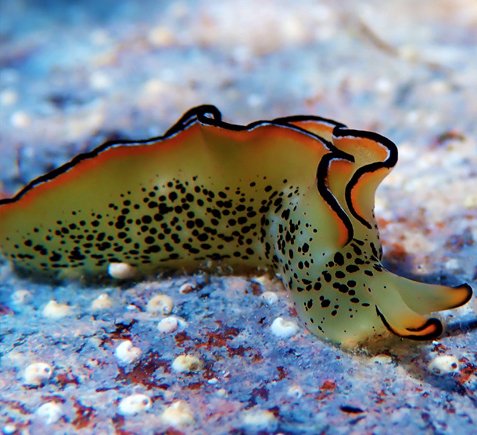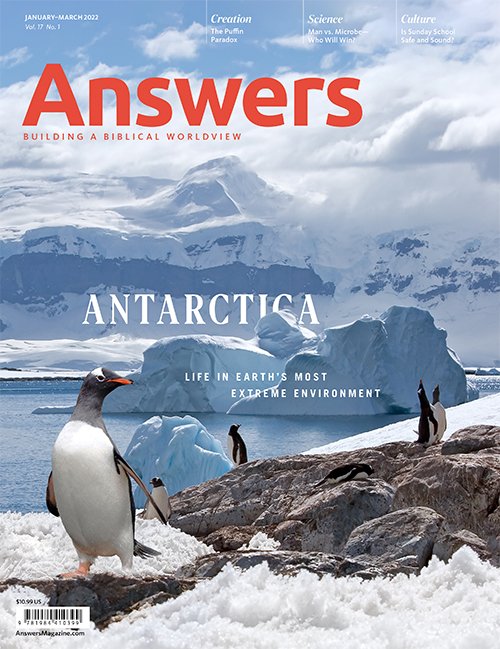Regeneration: Worth an Arm and a Leg
Evolution can’t account for an animal’s ability to regrow limbs or heal its body. But regeneration like this points to an all-wise Creator.
Morris was a bright-eyed tabby cat whose family loved him dearly. He would follow them around like a dog and even play catch. One Saturday morning, as the family rushed to an early soccer game, they forgot to close the garage door. After the games, they pulled into the garage and as they closed the door, they heard a terrible meow. To their horror, Morris had climbed to the top of the garage door and become trapped as the door was closing. The family rushed the crying cat to the veterinary hospital where I was working.
I administered potent pain medication and took X-rays of his spine. As I feared, the X-rays revealed that his spinal cord had been severely injured. It was hard to tell the family that he would likely never walk again. “However,” I said, “cats can do some amazing things. Don’t give up hope just yet.”
Normal walking requires two-way communication between the spinal cord and brain. Spinal injuries like Morris’ break the communication. In humans, this kind of injury would almost certainly mean lifelong paralysis. But some species have the instructions for walking sort of hardwired into their spinal cord, independent from the brain. Using this hardwired ability, Morris learned to walk again, allowing him to live more normally after such a devastating injury. Though it seems almost supernatural, this ability is a testimony to God’s design.
God equipped the world’s creatures with many other abilities that seem almost like superpowers to us. The mantis shrimp can see the whole spectrum of light including UV rays. The naked mole rat seems to be immune to cancer. The wood frog can freeze its own blood to survive in a cold habitat. Some spiders spin webs 10 times stronger than Kevlar (a strong synthetic fiber). The dung beetle can lift 1,141 times its bodyweight. The tardigrade can survive extreme temperatures, normally lethal doses of radiation, years without food or water, and even the vacuum of space.
Perhaps the ultimate animal superpower is regeneration—the ability to regrow severed limbs and damaged body parts. Many creatures, including humans, demonstrate aspects of regeneration. Though we would give an arm and a leg for the ability to regrow limbs and organs, this level of regeneration shows up mostly in animals such as insects, lizards and salamanders, fish, and worms.
But why would evolution—supposedly the result of undirected, random processes—relegate this fantastic ability to what it considers lower, lessevolved creatures and remove it from supposedly more complex, highly evolved animals such as mammals?
Evolution cannot answer this question, but it is not hard for creationists who believe God’s Word. In the garden of Eden, God endowed the original animal kinds with the variety of genetics that would allow their descendants to adapt fascinating abilities to face the perils in our now-fallen world.
Amazing Regenerative Abilities: Part One
Whether making a quick getaway or recovering from an injury, some creatures have incredible capabilities to regenerate parts of their bodies.
Off with Their Head
The sea slug Elysia cf. marginata never loses its head—but it does sometimes lose its body. Researchers suspect the slug detaches its head when its body becomes infected with parasites. The head continues crawling around until the creature regrows its missing body parts within 20 days.

Armed to the Teeth
Sharks have a continuous conveyor belt of teeth. When they lose a tooth, a new tooth is ready to move in from behind. A shark grows over 20,000 teeth in its lifetime.

Cut and Run
Spiny mice can shed up to 60% of their skin (a process known as skin autotomy), probably to escape from predators. The mice can regenerate skin, blood vessels, nerves, and cartilage. They are the only known mammals to exhibit skin autotomy.

A Tail of a Different Color
Some lizards can regrow their tails, but when they do, the new ones aren’t carbon copies of the originals. In fact, the appendage can grow back shorter, in a different color, or with a different scaling pattern.

Cost of Evolution
Many types of animals demonstrate great ability to regenerate and seem to do so through several different mechanisms. Because evolutionists constantly search for some sort of step-by-step process that points to natural selection and a change from one animal into another completely different animal, they assume that the capacity for regeneration evolved independently in each different animal, all of which ultimately descended from a common tetrapod (four-legged) ancestor with the ability to regenerate its limbs.1 This logic is completely without evidence. They have merely constructed a fictional common ancestor to add credence to their claim.
In contrast, creationists know that the capacity for regeneration in these diverse creatures did not arise from a common ancestor but from a common Designer who incorporates designs repeatedly across species and kinds.
Evolutionists must try to explain an organism’s amazing ability to regenerate by fitting it into a somewhat plausible evolutionary process. They believe the evolutionary cost of losing an ability must have been less than the evolutionary gain. In this case, evolution chose to gain functions that were more valuable at the cost of losing the capacity to regenerate. Animals with this ability could, theoretically, withstand almost any environmental catastrophe, allowing them to adapt, survive, and reproduce beyond any others. It is difficult to imagine a scenario in which an organism that could regrow an injured body part would not have a reproductive advantage over an individual that could not.
This glaring hole in their dogma challenges evolutionists to explain why and how simple organisms developed their amazing regenerative ability and why other so-called higher organisms seem to have lost this ability at great detriment to their adaptability and survival.
Higher and Lower Animals?
Evolution’s first problem lies in its classification of “simple” and “complex” animals.
When we look at creation, we clearly see some animals with less anatomical complexity, such as a worm with no arms or legs versus a person or a chimpanzee with both arms and legs. But creationists and evolutionists think of simple and complex creatures very differently.
Creationists believe that God provided each animal with the features and abilities to inhabit and function in its niche environment as a unique creation, not as part of some shared evolutionary timeline and progression of higher and lower creatures. He gave them exactly what they need to survive and reproduce in these specific niches. In his wisdom, he also gave them the genetic flexibility to change in subtle but significant ways in response to changes that would occur in their fallen environments. We call this adaptation. To a creationist, there really is no such thing as a simple or a complex creature. Each animal is a testimony to God’s genius, allowing creationists to freely admire and study each for its uniqueness.
Meanwhile, evolutionists’ belief in consecutive, gradual change driven by mutations and natural selection requires them to classify creatures as either simple or complex, lesser or greater. Their trust in this belief forces them to see every animal as part of a progression and not as a unique creature. To them, every animal is the result of billions of years of evolution and the foundation upon which additional billions of years of future evolution will work to produce more organisms with varying levels of complexity. This viewpoint makes it difficult for many evolutionists to accept the level of complexity seen in even the supposed simplest of creatures.
The closer we look at the smallest of creatures, the more complex we realize they are. For example, Planaria (small flat worms) have bilateral symmetry, meaning that they have identical left and right sides. They are flat with nerve ganglia (a collection of nerves) on each side of the head, both containing a photosensitive cluster of cells called an eyespot. Each ganglion branches out into a major nerve that runs down the length of the body on the right and left sides. If these creatures are cut into multiple pieces, an entirely new individual can regenerate from each piece.
Although their body design is simple in that they have fewer parts than, say, an orca or an elephant, Planaria are in no way simplistic. In fact, scientists are only just beginning to describe the processes involved in this creature’s regeneration.
Breaking Rules
Evolution is thought to be a mindless process, yet it is driven by rules and laws. According to a 1960 book on regeneration, the evolutionary rule on regeneration states, “The regenerative capacity of animals decreases with an increase in anatomical complexity.”2 It’s true that spectacular regenerative capability seems less evident in animals that are more anatomically complex.
But because evolution is an idea, not a fact, evolutionary rules aren’t always consistent. Some animals with quite complex specialized body structures can regenerate. A specialized structure is composed of multiple cell types. For example, a leg contains muscle cells, skin cells, hair cells, nerve cells, and many other kinds of cells. A prime example of regeneration in a creature with specialized structures is the axolotl. If its leg is amputated, this salamander can regenerate new cartilage, muscles, nerves, blood vessels, skin, and claws. And that’s not all. The axolotl can regenerate other specialized structures such as its brain, heart, lungs, and more.
The fact that we do not see such extreme regeneration in mammals and humans doesn’t mean God didn’t give us ways to mend damage.
The fact that we do not see such extreme regeneration in mammals and humans doesn’t mean God didn’t give us ways to mend damage. If my dog Coggins lost an ear, I wouldn’t expect it to grow back again. Similarly, if I cut off my thumb, I wouldn’t hold out for a new one to pop up. However, Coggins and I have other amazing regenerative capabilities. In most cases, we call these capabilities healing. If I scrape my skin, new skin will replace the damaged area within just a few days. If I break my leg, the bone can heal. I can suffer massive damage to my liver and in many cases even that will heal.3 The perpetual clockwork renewal of cells throughout our bodies—from our tastebuds to our toenails—is a testimony to the Creator’s generosity to provide for our survival.
Amazing Regenerative Abilities: Part Two
Tail-Gator
Alligators can regrow cartilage, connective tissue, and skin. Young gators can regrow up to nine inches of a lost tail, making them the largest animal with this regenerative ability.

A Broken Heart
Adult zebrafish can repair and regenerate their heart, brain, kidneys, spinal cord, fins, and pancreas. They avoid much scarring during the healing process thanks to large amounts of collagen.

Annual Antlers
Deer shed and regrow their antlers every year. They are the only mammals capable of fully regenerating a complex organ.

Sprouting Spiders
Spiders can regrow legs, although the regenerated leg is often thinner and shorter than the original. They can also regrow mouthparts, silk spinners, and pedipalps (the appendages in front of the legs used for sensing objects).

Starfish Restart
Sea stars (commonly known as starfish) can regenerate an entire limb if it is amputated. A whole new starfish individual can regenerate from a severed limb.

Moving Forward with Regeneration
The natural world abounds with abilities and features that humans mimic for our own uses. God didn’t give us wings for a bird’s-eye view or gills so we could keep an eye on the creation underwater, but he did give us the ingenuity to create airplanes and scuba gear. Similarly, scientists are diligently searching for ways to use the regenerative capabilities found in nature to help humans.
Using ever-improving technology, scientists can identify the specific regenerative genes in certain animals. For example, some research suggests that the same genetic markers of regeneration in Planaria and axolotls are present in humans and, though we shouldn’t expect to regrow toes or arms, researchers might one day “turn on” those markers to initiate more widespread renewal in our cells.
In June of 2021, scientists discovered the molecular signaling that prompts regeneration in the axolotl but leads to scarring in mammals. And researchers recently identified a gene partly responsible for nerve regeneration in African clawed frog tadpoles. They believe this discovery might lead to a treatment to help humans recover motor functions after spinal injuries.
Scientists are also fascinated with studying the human body’s capabilities for renewal. In 2021, researchers isolated the cells that replenish the liver. This information could lead to advanced treatment for liver conditions. Researchers have also made progress toward regrowing cartilage that has been damaged or worn thin between joints. Another study is looking for ways to treat hearing loss by regenerating hair cells in the ear using a lab-grown cochlea.
A Handy Ability
We might wonder why the all-powerful Creator, who tasked man with stewarding the earth, did not give us the fantastic power to regenerate. After all, the ability to grow a new hand would sure come in handy. But this question overlooks not only the amazing features God has equipped us with to survive but also the ingenuity that surpasses that of all other creatures, allowing us to copy God’s design in nature.
God designed us not only to rule his creation but also to rely on him. Maybe in his wisdom God didn’t give us the superpower of regeneration so that we would humbly acknowledge our limitations and understand our need for a relationship with our Jehovah Rapha—the God who heals.
In our fallen world, creatures that can regenerate dying tissues remind us of the regeneration that Jesus intends to bring one day when he creates the new heavens and new earth. Until then, we can give thanks that the same Creator who gave some creatures the ability to regrow limbs offers to regenerate our souls and minds when we repent of our sin and follow him.
Answers Magazine
January–March 2022
God created the world to be inhabited, right down to the frozen continent at the bottom of the globe.
Browse Issue SubscribeFootnotes
- Andrey Elchaninov, Gennady Sukhikh, and Timur Fatkhudinov, “Evolution of Regeneration in Animals: A Tangled Story,” Frontiers in Ecology and Evolution 9 (2021).
- M. Vorontsova and L. Liosner, Asexual Propagation and Regeneration (New York, NY: Pergamon Press, 1960).
- Healing in the liver usually takes place through cellular hypertrophy (cells multiplying and enlarging to take over the lost function of the damaged liver) but not recreating it as in true regeneration.
Recommended Resources

Answers in Genesis is an apologetics ministry, dedicated to helping Christians defend their faith and proclaim the good news of Jesus Christ.
- Customer Service 800.778.3390
- © 2024 Answers in Genesis






